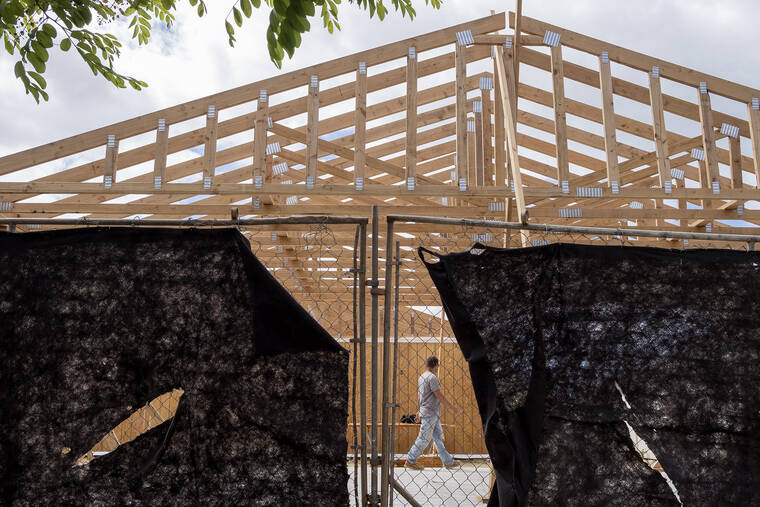A full 100 years have elapsed since the Hawaiian Homes Commission Act was passed by Congress. Suddenly, with nearly 29,000 still on the waiting list for the homestead promised by federal law, time is of the essence.
House Bill 2511 was passed by the state Legislature this year and awaits Gov. David Ige’s signature, which it certainly should get. Flush with cash from federal COVID-19 pandemic aid and the economic recovery it enabled, lawmakers took a once-in-a-century opportunity to invest $600 million in the Hawaiian Homes mission.
The hope is that such a large infusion will help the state Department of Hawaiian Home Lands make real progress in housing the Native Hawaiian beneficiaries who, federal authorities acknowledged, were owed such reparations after the U.S. annexation of the former Hawaiian kingdom. These beneficiaries are those of 50% or more Hawaiian blood who are eligible.
The reality is, more than a half billion dollars is a large sum that’s vulnerable, nonetheless, to being squandered through inaction.
So the final draft of HB 2511 directed DHHL to prioritize projects to be financed, through development of a strategic plan aimed at delivering applicants’ preferences. This is rational: Social conditions have changed, and a new roadmap for the Hawaiian Homes mission is warranted.
The legislation cites the preferences recorded in the 2020 Beneficiaries Study Applicant Report: 76% would rather have a lot with a single-family home or a vacant house lot; and 16% would prefer a rental or rent-to-own unit.
Stated preferences aren’t the only criteria that should guide the spending, however. There are some harsh realities to confront as well.
Also in 2020, a continuing investigation by the Honolulu Star-Advertiser and the nonprofit ProPublica found that for many families, the mortgage on a subdivision home in most DHHL developments was simply out of reach financially.
There is a guideline for spending the $600 million, a tentative project list outlined in an earlier version of HB 2511. But the purpose of a large taxpayer commitment to the project is to meet the broad public interest of reducing the affordable housing deficit. Helping these people, including many who have waited for decades for a lease, is essential to success, and will require new thinking.
Beneficiary advocacy groups — principally the Sovereign Council of Hawaiian Homestead Associations and the Association of Hawaiians for Homestead Lands — are stepping up to provide their input. More specifically, their leaders told the Star-Advertiser they don’t trust DHHL to do the right thing and so are developing their own spending plan.
They have good reason to be skeptical. Over many years, DHHL has come under fire, by federal and state officials, for mismanagement, everything from inconsistencies in leasing practices that were supposed to produce revenue for development, to simple failure to deliver leases to beneficiaries.
After the groups’ first meeting to gather feedback, already it’s plain that an accord will be elusive. There are those who believe that the applicant’s position on the waitlist is the strict basis for their place in line for these funds.
But others say the spending plan should favor those in greatest need. Many have passed on offers of leases because they couldn’t afford them.
In fairness, DHHL has shown willingness to try new approaches in recent years, turning to more multi-unit and rental projects. If beneficiary groups convey their ideas in short order, DHHL should look for ways to incorporate them.
Ultimately, though, its leadership, including the policymaking Hawaiian Homes Commission, should be the ones to analyze data and arrive at a formula that could help guide DHHL spending even after the current $600 million allocation is exhausted.
Weighting that formula to make the best use of the cash allotment — moving the most eligible claimants from the waiting list to homes, and as soon as possible — should be the goal.
And financial need has to be a major factor in the formula, in addition to seniority on the list. This includes allocating some of the money for rental assistance, and for helping families get finances in order to carry a mortgage.
It makes sense, too, to look through the roster of projects identified as good prospects for development in the Senate draft of HB 2511. Shovel-readiness of a project should count in its favor, too.
The deadline matters most, in the end. This is not a time for endless discussions leading to stalemate. The spending plan is due Dec. 10, and with the change in gubernatorial administration soon to follow, implementation could bog down. The money must be allocated by June 30, 2025, or it reverts to the general fund.
“If even $1 of this lapses because it went unused, I think that will be a disaster,” said state Sen. Jarrett Keohokalole. That’s not an exaggeration.
In January, when DHHL reports back to the Legislature, let’s hope it will be a story of disaster averted.

